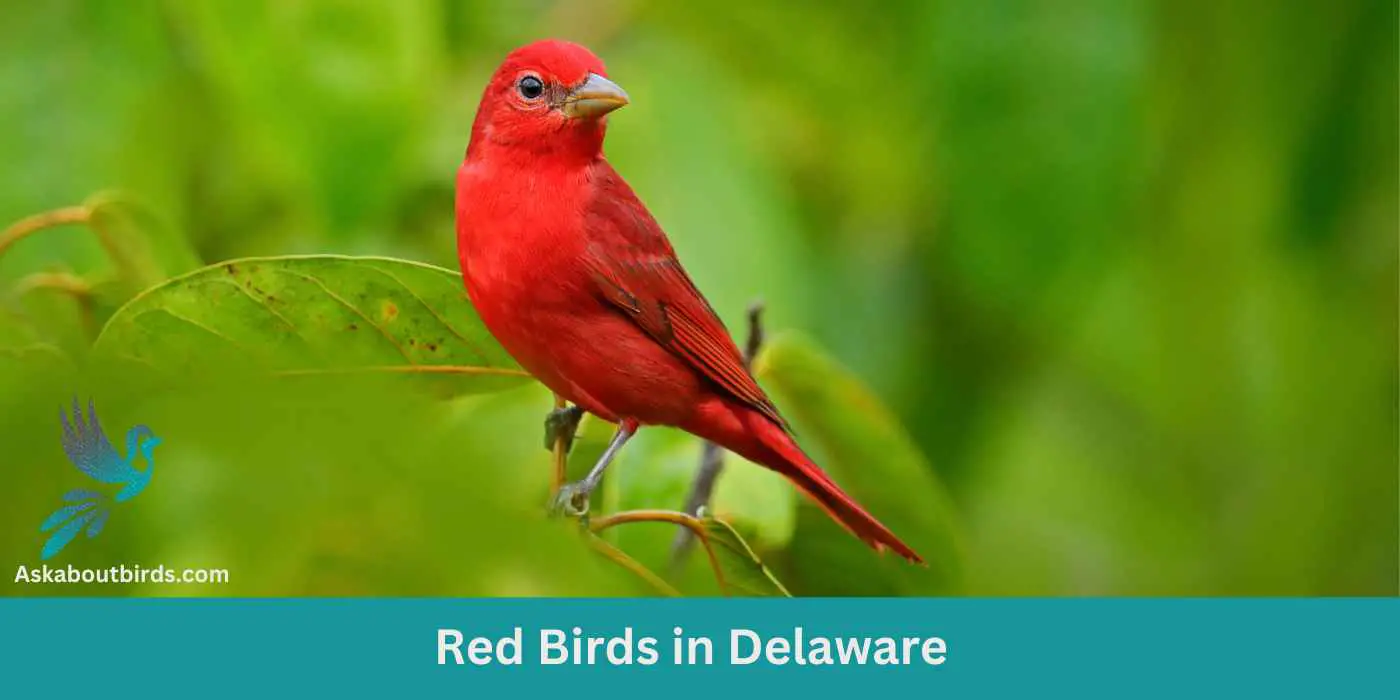Delaware, the First State, is not just rich in history but also in its vibrant avian life. With habitats ranging from coastal marshes to woodlands, it serves as a haven for birdwatchers. Dive into our guide to discover the 8 resplendent red birds that grace Delaware’s skies and landscapes.
Red Birds Found In Delaware
Delaware’s unique position along the Atlantic Flyway makes it a crucial stopover for many migratory birds. Its diverse ecosystems, from the tidal salt marshes of Bombay Hook to the dense woodlands of Redden State Forest, provide varied habitats catering to a multitude of avian species.
Northern Cardinal


| Feature | Measurement |
|---|---|
| Scientific Name | Cardinalis cardinalis |
| Length | 8.3 – 9.1 in |
| Wingspan | 9.8 – 12.2 in |
| Weight | 1.19 – 2.29 oz |
The Northern Cardinal is an iconic North American bird, easily recognized by its vibrant color and melodious song.
Appearance: Male Northern Cardinals are a brilliant scarlet red, while females display a more subdued reddish olive. Both sexes have a distinctive black ‘mask’ on their face around the bill and a pointed crest on their head. The bird’s beak is robust, cone-shaped, and bright orange in color.
Diet: Northern Cardinals are primarily granivorous, with a diet largely consisting of seeds and grains. They also eat fruits and insects. These birds typically feed off the ground and are frequent visitors to bird feeders.
Reproduction: Northern Cardinals are monogamous, and a pair will breed together for life. The female typically builds a well-hidden nest in a dense thicket or shrub. She lays 2-5 eggs per clutch, which she incubates for around two weeks.
Scarlet Tanager


| Feature | Measurement |
|---|---|
| Scientific Name | Piranga olivacea |
| Length | 6.3 to 7.5 in |
| Wingspan | 9.8 to 11.8 in |
| Weight | 23.5 to 38 g |
The Scarlet Tanager is a strikingly colorful bird known for its brilliant plumage and distinctive song.
Appearance: Male Scarlet Tanagers are notable for their vibrant scarlet bodies contrasted with black wings and tail, making them one of the most intensely colored birds. Females and juveniles, on the other hand, have a subdued olive-yellow body color with darker wings and tail.
Diet: The diet of the Scarlet Tanager is largely made up of insects, including beetles, cicadas, aphids, and others. They are adept flycatchers, seizing insects in mid-air or picking them off foliage. They also consume fruits and berries, especially during migration and in their winter habitats.
Reproduction: The female Scarlet Tanager builds a cup-shaped nest using twigs, rootlets, and grass, typically well-hidden in the dense foliage of trees. She lays 3 to 5 eggs and incubates them for about two weeks.
Summer Tanager


| Feature | Measurement |
|---|---|
| Scientific Name | Piranga rubra |
| Length | 6.7 in |
| Wingspan | 28 to 30 cm |
| Weight | 29 g |
The Summer Tanager is a medium-sized songbird admired for its radiant plumage and melodious song.
Appearance: Male Summer Tanagers are an impressive bright red, while females and juveniles present a softer, yellow-orange color. Both genders have a large, slightly hooked bill and relatively short tail.
Diet: Summer Tanagers primarily feed on insects, including bees and wasps, which they catch in flight or pick off vegetation. They are also known to eat fruits and berries, making them helpful in controlling pest populations and seed dispersal.
Reproduction: The female Summer Tanager builds a loose, shallow cup-shaped nest out of twigs and grass, usually hidden in the foliage of trees. The female typically lays 3-5 eggs, which she will incubate for about two weeks.
Red-Winged Blackbird
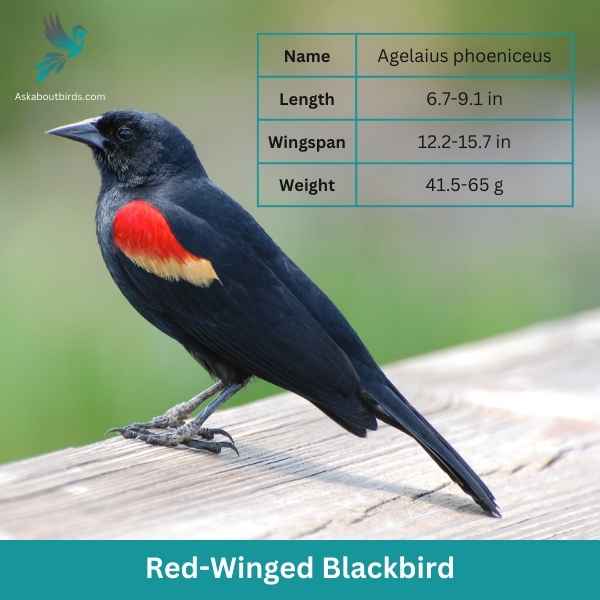
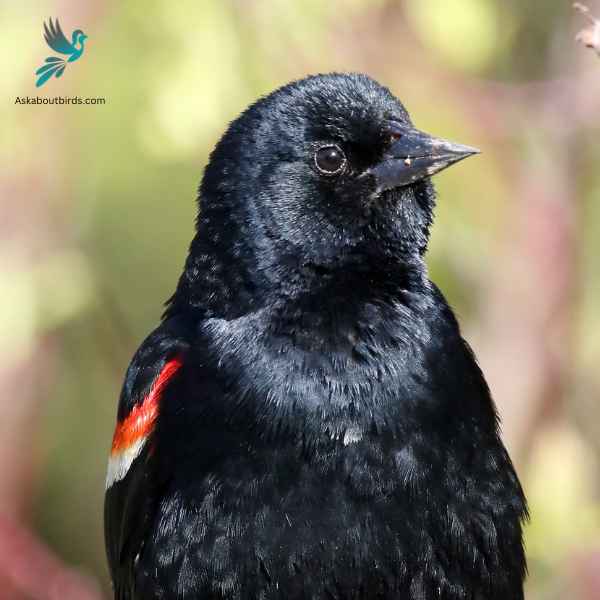
| Feature | Measurement |
|---|---|
| Scientific Name | Agelaius phoeniceus |
| Length | 6.7-9.1 in |
| Wingspan | 12.2-15.7 in |
| Weight | 41.5-65 g |
The Red-Winged Blackbird is a familiar sight across North America, especially in wetlands and open areas. Known for its striking coloration and distinct call, it is often seen perched on cattails or utility lines.
Appearance: Male Red-Winged Blackbirds are glossy black with bright red-and-yellow shoulder patches, while females are streaky brown, resembling a large sparrow. The males’ red patches become more prominent when they’re displaying or agitated.
Diet: Red-Winged Blackbirds primarily feed on seeds and insects. Their diet includes grains, sunflower seeds, and corn, but they also eat beetles, caterpillars, and other small invertebrates, especially in the breeding season.
Reproduction: Red-Winged Blackbirds nest in marshes, along watercourses, and in wet fields. The female constructs a cup-shaped nest using grass and sedge, attaching it to plants above water. She typically lays a clutch of 3 to 4 blue-green eggs, which she incubates for about 11-12 days. Males, being polygynous, often have multiple mates during a single breeding season.
Red-bellied Woodpecker
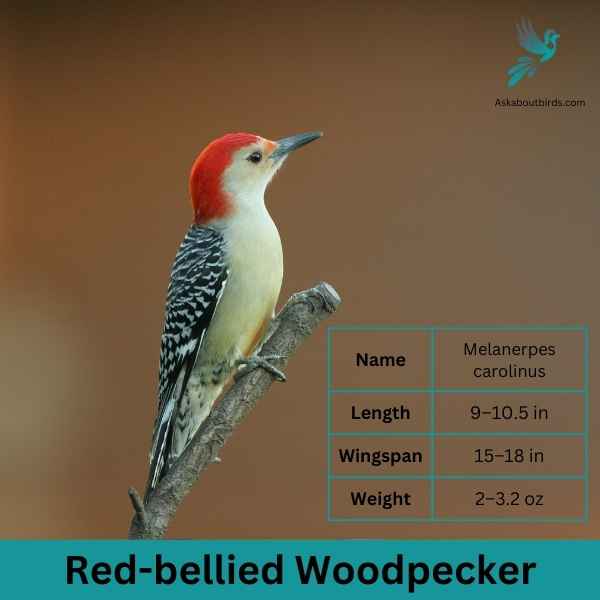
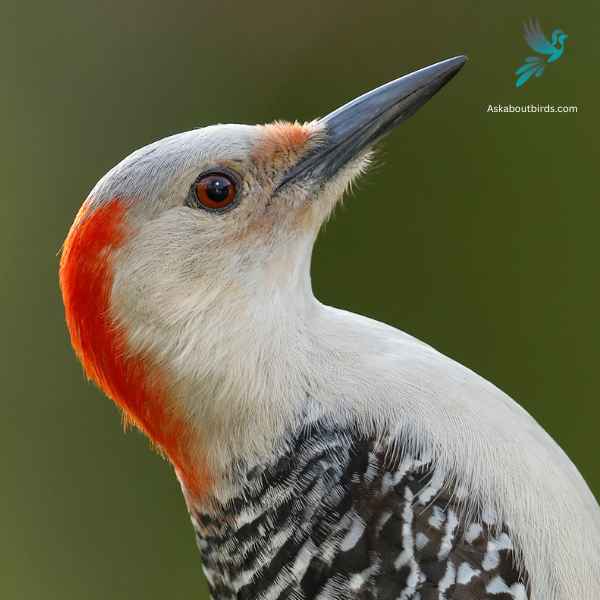
| Feature | Measurement |
|---|---|
| Scientific Name | Thryothorus ludovicianus |
| Length | 4.7–5.5 in |
| Wingspan | 11 in |
| Weight | 0.63–0.81 oz |
The Red-bellied Woodpecker is a medium-sized woodpecker commonly found in woodlands, forests, and backyards across the eastern and central U.S.
Appearance: The Red-bellied Woodpecker sports a pale gray face, throat, and belly, contrasted by a zebra-striped back. Its name derives from the subtle reddish tinge on its belly, but it’s more commonly recognized by the vivid red cap on the head of males and the partial red cap on females.
Diet: This woodpecker has a varied diet that includes insects, fruits, nuts, and seeds. They frequently forage on tree trunks and branches, using their sticky, barbed-tipped tongue to extract ants, beetles, and other insects from crevices.
Reproduction: Red-bellied Woodpeckers are cavity nesters, excavating holes in tree trunks for their nests. The inside of the nest is typically unlined or sparingly lined with wood chips.
House Finch


| Feature | Measurement |
|---|---|
| Scientific Name | Haemorhous mexicanus |
| Length | 5–6 in |
| Wingspan | 8–10 in |
| Weight | 0.6–0.9 oz |
The House Finch is a small songbird widely distributed across North America and is commonly found in urban and suburban areas.
Appearance: Males of this species are brightly colored with crimson faces and throats, which can extend to the chest and back, while their flanks have streaks. The female is streaked brown and lacks the red coloring. Both have a square-tipped tail and a distinctively long, flat-topped bill.
Diet: House Finches primarily eat seeds, grains, and berries. They have a particular fondness for sunflower seeds and can be commonly seen at bird feeders. Occasionally, they will also consume insects, especially during the breeding season.
Reproduction: House Finches are cavity-nesters and might choose ledges, vents, ledges, and other urban settings. They might also utilize trees or shrubs. Their nests can be made of a wide array of materials, from feathers to twigs.
Purple Finch


| Feature | Measurement |
|---|---|
| Scientific Name | Haemorhous purpureus |
| Length | 4.7–6.3 in |
| Wingspan | 4.7–6.3 in |
| Weight | 0.6–1.1 oz |
The Purple Finch is a vibrant songbird often mistaken for its close relative, the House Finch, but it exhibits a different hue and patterns.
Appearance: Males are raspberry red on the head, throat, and breast, with streaky brown backs and wings. The intensity of the red can vary among individuals. Females are brown and streaked all over but might show a slight blush on the face. They lack the strong facial patterns seen in female House Finches.
Diet: Purple Finches primarily consume seeds, with a preference for sunflower seeds, dandelion seeds, and buds. They also eat insects and berries, especially during the breeding season.
Reproduction: These finches often nest in conifers or mixed woodlands. The nest, typically located on a horizontal branch, is made from twigs and grass, then lined with feathers.
American Redstart


| Feature | Measurement |
|---|---|
| Scientific Name | Setophaga ruticilla |
| Length | 4.3 to 5.5 in |
| Wingspan | 6.3 to 9.1 in |
| Weight | 8.6 g |
The American Redstart is a lively warbler known for its vivid colors and active hunting style, often seen flitting about, fanning its tail to startle and catch insects.
Appearance: Adult male American Redstarts boast striking black plumage with bright orange patches on the sides, wings, and tail. Females and immature males have grayish-olive upperparts with yellow patches in the same areas where the males display orange.
Diet: American Redstarts are primarily insectivores. They actively forage for flying insects, as well as caterpillars and spiders, often using their colorful tails to startle prey and make them easier to catch.
Reproduction: The female American Redstart builds a cup-shaped nest in the fork of a tree branch. Typically, she lays a clutch of 3 to 5 eggs. The female takes on the primary responsibility of incubating the eggs, while both parents participate in feeding the fledglings after they hatch.
Where to Spot Delaware’s Red Birds
Delaware, a gem for birdwatchers, offers diverse landscapes that harbor an array of avian treasures. Below are the top spots I’ve identified in the state where the vibrancy of red birds and other species come alive:
- Bombay Hook National Wildlife Refuge: A paradise for migratory birds, Bombay Hook provides a diverse habitat of tidal salt marshes, freshwater ponds, and grasslands, making it an ideal spot to witness a myriad of bird species year-round.
- Prime Hook National Wildlife Refuge: Another coastal haven, this refuge encompasses over 10,000 acres of marsh, forest, and scrub habitats. The diversity in landscape ensures sightings of numerous birds, from vibrant reds to subtle blues.
- Cape Henlopen State Park: Located where the Delaware Bay meets the Atlantic Ocean, this park offers birdwatchers coastal dunes, pine woods, and salt marshes, ensuring a different birdwatching experience with each visit.
- Brandywine Creek State Park: With its hardwood forests and open meadows, this park is a haven for songbirds and raptors alike. The varied topography also attracts a wide variety of red bird species.
- Redden State Forest: A massive expanse of over 12,000 acres, this forest is a blend of pine and hardwood forests. Its secluded nature makes it a serene spot for spotting some of the state’s most vibrant avian inhabitants.
| State’s Red Birds | Top Spots for Red Birds |
|---|---|
| Maryland’s Red Birds | 1. Blackwater National Wildlife Refuge 2. Patuxent Research Refuge 3. Catoctin Mountain Park |
| New Jersey’s Red Birds | 1. Cape May Bird Observatory 2. Great Swamp National Wildlife Refuge 3. Edwin B. Forsythe National Wildlife Refuge |
| Pennsylvania’s Red Birds | 1. Hawk Mountain Sanctuary 2. John Heinz National Wildlife Refuge 3. Presque Isle State Park |
FAQs on Red Bird Species Found in Delaware
Where are painted buntings commonly found?
Painted buntings, with their bright red plumage and distinctive appearance, are primarily native to Central and South America. These medium-sized birds, characterized by their bright yellow-green and red body, often inhabit forest edges and the forest canopy. Their vivid colors make them standout among other birds and a favorite for birdwatchers.
What are some distinguishing features of the house finch?
The house finch, known by its scientific name, is a common bird found in many regions. Males typically exhibit bright red plumage on their bodies, contrasting with brown streaks and a pale bill. Their reddish-brown appearance, complemented by a white belly and long tails, often attracts bird enthusiasts. They’re also known to gather in large flocks, especially around bird feeders.
How can one attract red birds to their bird feeder?
Attracting bright red birds, such as the painted bunting, requires specific strategies. Using bird feeders filled with weed seeds can entice these colorful birds. Placing the feeder near forest edges or under the forest canopy provides a natural environment that red birds prefer. Additionally, ensuring the feeder is visible from the sky and is safe from predators enhances the likelihood of visits from wild birds with bright red plumage.
What are some identifying features of white-winged crossbills?
White-winged crossbills are distinctive birds with two white wing bars that set them apart from other species. These bars, coupled with their unique crossbill, make them easily identifiable. They are known to visit bird feeders, especially if they offer black oil sunflower seeds, which are a favorite among many bird species.

